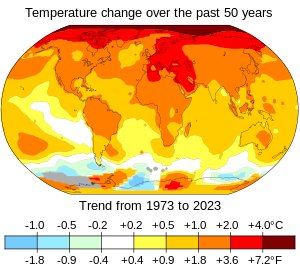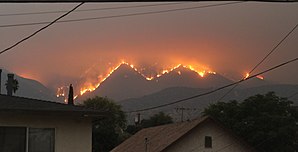Terminology and Observed temperature rise
– Before the 1980s, scientists used the term ‘inadvertent climate modification’ to refer to human impacts on the climate.
– In the 1980s, the terms ‘global warming’ and ‘climate change’ became more common.
– ‘Global warming’ refers to increased surface warming, while ‘climate change’ describes the totality of changes to Earth’s climate system.
– ‘Global warming’ became popular after NASA climate scientist James Hansen used it in his 1988 testimony.
– Since the 2000s, ‘climate change’ has increased in usage.
– New high temperature records have outpaced new low temperature records on a growing portion of Earth’s surface.
– Oceans absorb over 90% of the heat from global warming, leading to an increase in ocean heat content.
– Multiple independent instrumental datasets show that the climate system is warming.
– A global warming hiatus from 1998 to 2013 was likely caused by negative phases of the Pacific Decadal Oscillation and Atlantic Multidecadal Oscillation.
– The 2013-2022 decade warmed to an average of 1.15°C compared to the pre-industrial baseline.
Causes of climate change
– Human activity, such as burning fossil fuels, is the primary cause of the current rapid rise in global average temperature.
– Fossil fuel use, deforestation, and certain agricultural and industrial practices contribute to greenhouse gas emissions.
– Greenhouse gases trap heat in Earth’s lower atmosphere, causing global warming.
– Increased greenhouse gas concentrations result in larger amounts of heat being trapped, leading to amplified warming.
– Climate change is also influenced by natural forces, but human activity is the dominant driver.
Impacts of climate change
– Climate change is causing deserts to expand and heat waves and wildfires to become more common.
– Melting permafrost, glacial retreat, and sea ice loss are consequences of amplified warming in the Arctic.
– Higher temperatures are causing more intense storms, droughts, and other weather extremes.
– Rapid environmental change is forcing many species to relocate or become extinct.
– Climate change threatens people with increased flooding, extreme heat, food and water scarcity, disease, and economic loss.
Mitigation and adaptation
– Limiting warming to 1.5°C requires halving emissions by 2030 and achieving net-zero emissions by 2050.
– Reducing emissions involves reducing energy use and transitioning to low-carbon sources of electricity.
– Phasing out coal and natural gas power plants and increasing wind, solar, and nuclear power generation are necessary steps.
– Carbon removal from the atmosphere can be achieved through methods like increasing forest cover and capturing carbon in soil.
– Adapting to climate change through measures like flood control and drought-resistant crops can partially reduce risks, but there are limits to adaptation.
Greenhouse gases, Aerosols and clouds, and Land surface changes
– Greenhouse gases trap heat near the Earth’s surface.
– Water vapor and clouds contribute the most to the greenhouse effect.
– Human activity has increased greenhouse gas concentrations since the Industrial Revolution.
– Concentrations of CO2 and methane have increased significantly since 1750.
– Fossil fuel burning is the main source of greenhouse gas emissions.
– Aerosols scatter and absorb solar radiation.
– Global dimming, caused by aerosols, reduces the amount of sunlight reaching the Earth’s surface.
– Sulfate aerosols lead to clouds that reflect solar radiation more efficiently.
– Indirect effects of aerosols are the largest uncertainty in radiative forcing.
– Black carbon in soot contributes to global warming and melting of snow and ice.
– Global tree cover loss has doubled since 2001.
– Agriculture takes up a significant portion of Earth’s land area.
– Deforestation releases CO2 and prevents further absorption.
– Deforestation for agriculture, such as beef and palm oil production, is a major cause.
– Forested land continues to decrease, exacerbating global warming. Source: https://en.wikipedia.org/wiki/Climate_change
In common usage, climate change describes global warming—the ongoing increase in global average temperature—and its effects on Earth's climate system. Climate change in a broader sense also includes previous long-term changes to Earth's climate. The current rise in global average temperature is more rapid than previous changes, and is primarily caused by humans burning fossil fuels. Fossil fuel use, deforestation, and some agricultural and industrial practices add to greenhouse gases, notably carbon dioxide and methane. Greenhouse gases absorb some of the heat that the Earth radiates after it warms from sunlight. Larger amounts of these gases trap more heat in Earth's lower atmosphere, causing global warming.


Climate change is causing a range of increasing impacts on the environment. Deserts are expanding, while heat waves and wildfires are becoming more common. Amplified warming in the Arctic has contributed to melting permafrost, glacial retreat and sea ice loss. Higher temperatures are also causing more intense storms, droughts, and other weather extremes. Rapid environmental change in mountains, coral reefs, and the Arctic is forcing many species to relocate or become extinct. Even if efforts to minimise future warming are successful, some effects will continue for centuries. These include ocean heating, ocean acidification and sea level rise.
Climate change threatens people with increased flooding, extreme heat, increased food and water scarcity, more disease, and economic loss. Human migration and conflict can also be a result. The World Health Organization (WHO) calls climate change the greatest threat to global health in the 21st century. Societies and ecosystems will experience more severe risks without action to limit warming. Adapting to climate change through efforts like flood control measures or drought-resistant crops partially reduces climate change risks, although some limits to adaptation have already been reached. Poorer communities are responsible for a small share of global emissions, yet have the least ability to adapt and are most vulnerable to climate change.
Many climate change impacts are already felt at the current 1.2 °C (2.2 °F) level of warming. Additional warming will increase these impacts and can trigger tipping points, such as the melting of the Greenland ice sheet. Under the 2015 Paris Agreement, nations collectively agreed to keep warming "well under 2 °C". However, with pledges made under the Agreement, global warming would still reach about 2.7 °C (4.9 °F) by the end of the century. Limiting warming to 1.5 °C will require halving emissions by 2030 and achieving net-zero emissions by 2050.
Strategies to phase out fossil fuels involve conserving energy, generating electricity cleanly, and using electricity to power transportation, heat buildings, and operate industrial facilities. The electricity supply can be made cleaner and more plentiful by vastly increasing deployment of wind, and solar power, alongside other forms of renewable energy and nuclear power. Carbon can also be removed from the atmosphere, for instance by increasing forest cover and farming with methods that capture carbon in soil.



![A dry lakebed in California, which is experiencing its worst megadrought in 1,200 years.[17]](http://upload.wikimedia.org/wikipedia/commons/thumb/d/d3/California_Drought_Dry_Lakebed_2009.jpg/129px-California_Drought_Dry_Lakebed_2009.jpg)